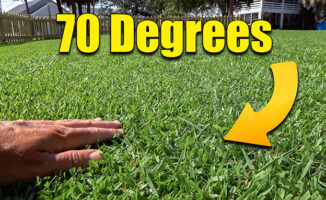Late Fall Bermuda Grass Care
In the this video Doc discusses everything about late fall Bermuda grass care. The reduction of sun impacts our Bermuda grass growth. We need to think about Bermuda grass cutting height. Fall army worms may still be eating our Bermuda lawn. Pre-Emergents need to be started on our Bermuda lawn. The switch from granular fertilizers to spray supplements is upon us.
Fall Bermuda Video
Fall Lawn Care Products
Sign Up for Email Alerts and Newsletters
Mowing: Continue to mow the bermuda grass lawn at the normal mowing height until the weather starts to cool in the fall. Once nighttime temperatures fall below 70 °F, slightly raise the mower to allow more leaf surface. This will allow the turf to become acclimated by the time the first frost occurs.
Fertilization: Do not apply nitrogen at this time. Lime or sulfur may be added if recommended by a recent soil test.
Irrigation: In the absence of rainfall, continue to water to prevent drought stress. After the lawn has become dormant, water as needed to prevent excessive dehydration. This is especially important if warm, bright days preceed days forecasted to be in the low 20’s or lower.
Insect Control: Any insects that were missed during the nymphal stage in the summer will have grown to a size where damage is occurring. Apply an insecticide to reduce the population and reduce further turf damage. This is best done before the first frost.
Disease Control: For disease control, especially large patch, it is extremely important to treat with fungicides during the fall months. With warm temperatures through September and the possibility of excessive rainfall that may occur during that period, diseases can spread rapidly. However, with cooler nights and shorter day lengths, control can be quite difficult because of slow turf recovery during this time. Turf weakened by disease in fall will be slow to recover in the spring; therefore, fungicide applications are needed to control disease before the grass goes dormant. In certain situations where large patch has been prevalent yearly, preventative fungicide applications may be needed starting in early October to stay a head of the disease. For more information on disease control.
Weed Control: Many winter annual grassy and broad leaf weeds can be managed by applying a pre-emergent herbicide in September with a second application 8 to 10 weeks later. Follow all label directions on the product for application rate. Granular herbicides must be watered into the soil soon after application. Follow label directions as to post application watering.
Broadleaf weed herbicides can be applied as necessary for control of chickweed, henbit, and other cool-season broadleaf weeds. Bermuda grass is sensitive to certain herbicides, such as 2,4-D, so follow label directions for reducing rates and use with caution. Selective herbicides can also be applied during winter for control of annual bluegrass and other winter annual grassy weeds. Contact the local County Extension office or the Home & Garden Information Center for weed identification and control measures.
Note: We do not sell or distribute any personal information.










